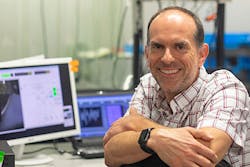University of South Carolina startup breaks ground in nano-optical manufacturing
Thomas Crawford, a physics professor at the University of South Carolina, has sold the start-up company he founded, MagAssemble, which aids in the manufacture of diffractive optical elements (DOEs), to Thorlabs.
Crawford, who arrived at the University of South Carolina (Columbia, SC) in 2005 with extensive research experience in disk drive technology, directed his lab in recent years in developing a novel manufacturing process that uses disk drive technology to assemble magnetic nanoparticles. When it became obvious that industry was interested in using the new technology, MagAssemble was born. Several university physics graduates comprised the startup’s staff, including chief scientist Longfei Ye, who earned his doctorate under Crawford’s direction.
“Traditional electronics fabrication technology is expensive for manufacturing micro- and nano-optics,” Crawford says. “Because the size of photonic devices are tied to the wavelength of light (400-700 nm for visible light), the same scaling rules that have pushed integrated circuits to single nanometer sizes cannot be applied to photonics, which is where MagAssemble’s method for nano-manufacturing comes in.
“It would cost industry $10 million to $20 million using semiconductor manufacturing to create patterned optical materials that we can make with equipment costing significantly less. The lack of scaling means the higher cost is passed along to the customer, and these costs have inhibited development of nano-optics.”
MagAssemble’s patented “pattern transfer nanomanufacturing” process is used to make custom diffractive optical elements and has potential applications ranging from smart phone cameras to optical-fiber communications to hyperspectral imaging. This past May the intellectual property developed by Crawford and his team was acquired by Thorlabs.
“It’s been an amazing experience—a really dicey, by-the-seat-of-the-pants kind of experience to be honest,” Crawford says. “Ninety out of 100 startups fail not because they don't have good technology but because they don’t have any or enough customers. We were able to stay alive just long enough to interest a company like Thorlabs, which is now providing the funds needed to take it the rest of the way.”
Thorlabs has retained MagAssemble’s staff and is leasing space in the University of South Carolina's Horizon building to continue research collaboration with university faculty and students.
Jason Williamson, a 1993 university graduate and CEO of Cirtemo, also in Columbia, partnered with Crawford to help commercialize MagAssemble’s manufacturing process. Williamson had previously worked with university chemistry professor Mickey Myrick to develop another startup called Ometric, which made patented optical filters and was acquired by energy-giant Halliburton in 2011. Williamson licensed the remaining nonenergy-related intellectual property of Ometric to form Cirtemo (Ometric spelled backwards), which was also sold to Thorlabs in May.
Williamson is now working in Thorlabs’ new division in Columbia, which is investing heavily in personnel and manufacturing equipment.
“Thorlabs got excited about the technology at Cirtemo and MagAssemble and liked the idea of starting a Southeastern location,” Williamson says. “For me, being from Columbia and seeing what the potential is, it’s super exciting. They’re allocating millions to hire the team and bring in the equipment we need.
Crawford is excited, too, not only to see his former startup blossom, but also to return to what he loves.
“To have exited all of this with a positive sale makes it satisfying,” he says. “Now I’m really excited to get back to research and innovation.”
Source: https://www.sc.edu/uofsc/posts/2019/08/startup_company.php

John Wallace | Senior Technical Editor (1998-2022)
John Wallace was with Laser Focus World for nearly 25 years, retiring in late June 2022. He obtained a bachelor's degree in mechanical engineering and physics at Rutgers University and a master's in optical engineering at the University of Rochester. Before becoming an editor, John worked as an engineer at RCA, Exxon, Eastman Kodak, and GCA Corporation.
